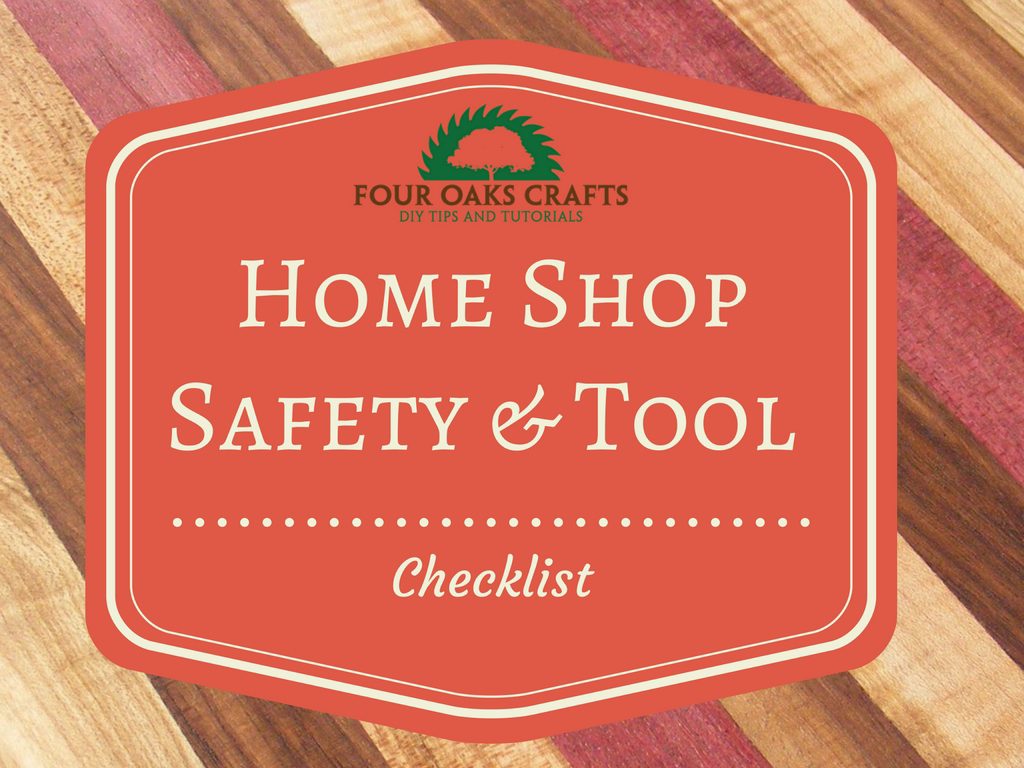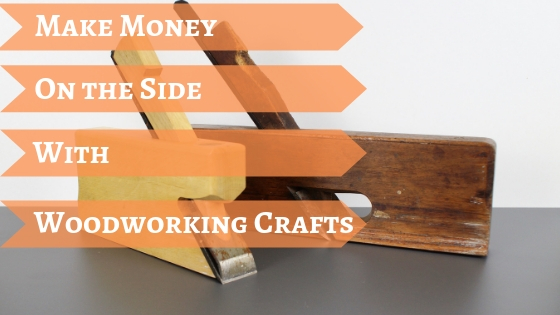I can remember the first time I sold one of my handmade wooden pens. I was so excited. To think someone would hand over their hard-earned money to buy something I made. I believe you will experience that same thrill. To help you achieve the goal of making money on your crafts (or your crafting knowledge and skills), I’ve put together this article — Make Money on the Side with Woodworking Crafts. It’s fairly comprehensive, with 42 tips and ideas, to be exact.
You may see me emphasizing woodworking crafts here, but these tips easily transfer to many other crafts, besides woodworking. So, in this article, I’ll simply use the word “craft.”
Just remember — they are ideas, and I don’t claim to have tried all of them. And I can’t guarantee which ones (or one) will bring you success. That will be up to you according to your unique station in life, your talents, and your determination.
Some of you may decide to seek different levels with selling your crafts. Full time? Side-hustle business? Occasional sells? There are many ways to do this.
Please — don’t quit your day job. This isn’t a get-rich-quick endeavor. Start small and learn.
Network and learn from others. Get advice about proper legal and accounting practices. Be patient and don’t give up. Above all — enjoy making things.
A few links below may be affiliate links which means if you purchase something, I receive a small commission. You won’t be paying any extra, and I use the commissions to provide more free content on this site. Thanks for you support!
Ways and Places to Make Money on Crafts
1 — Attend and sell at craft fairs. This requires a time commitment, because you’ll need to attend quite a few craft fairs to make a living this way. If you’re going for some supplemental cash, then maybe not so much.
You’ll need to account for expenses like: travel, overnight stays, gas, and cost of having a booth. You’ll also need to have a decent inventory and a variety of items to sell. You’ll want items on the high end to sell and items on the low end.
Here’s an article you might want to check out: How to Sell at Craft Fairs and Shows
2 — Sell your crafts online. Etsy is a very popular marketplace for selling crafts online. You set up a store-front page on the Etsy site and Etsy get’s a small percentage of what you sell.
There are other online outlets similar to Etsy. Ebay may be another option.
You’ll probably need to look into getting a PayPal account or something similar, if you and your customers do transactions with credit cards. I have read enough to know that Etsy has some great articles and forums to help you get started.
Here’s a great article that will show you more outlets for selling your crafts: 17 Ways to Sell Crafts From Home
3 — Sell through your own website. This is an alternative to Etsy. Etsy will get you exposure more quickly to people who want to buy crafts. With your own site, you’ll need to work more on promoting it and getting it in front of craft buyers.
You will also need to learn more about setting up a website or hiring someone to help you.
The good part of having your own site, is that you totally own it and control it. If Etsy shuts down tomorrow (which it probably will not) you still have ownership of your site.
Some people opt to have their own site, and then link out to an Etsy site to sell their items. You can also use eCommerce plugins for your site to process sells and fulfill orders. So there are many options to choose from.
Bluehost is the hosting service I use for my website. I highly recommend it if you’re just starting out. It’s easy to use and the customer service is great.
4 — Sell woodworking plans. If you have access to a drawing tool and can make your own unique plans, then you could make some money this way. Keep in mind — you will be competing with lots of other free plans out on the internet.
You’ll still need to figure out an avenue to sell the plans. That could be through your own website, a woodworking store, or maybe another online site that sells plans.
Will you deliver them via hard copy or electronically or both? These are questions you need to think out.
Make sure that your plans are unique and you’re not infringing on someone else’s copyright.
I started using a company called Gumroad and it’s free. I build the plans, then turn the file into a PDF and upload to Gumroad.
5 — Teach a woodworking or DIY course. If you go the instructor-led route, talk to a local woodworking store or maybe a technical school. See if they would be open to collaborating and allowing you to teach for them.
For a store, this could help them sell their products and bring traffic through the door. Some technical or vocational schools offer enrichment-type courses.
Whether you do this on your own or with another partner, make sure you’ve worked out all safety precautions and who will assume the liability. Speak with a lawyer, but at a minimum I’d think you would want to get participants to sign a release.
Another route might be to use a site like Udemy or YouTube to create video and online training. You could also host some type of training on your own site.
6 — Write a DIY book. If you’re a decent writer and can take good photos, a DIY book might be another option for making some money off your passion. The good news is that it’s easier than ever to create your own book. The bad news is that thousands are doing it.
So if you go this route, you’ll need to produce a compelling and useful book — at a minimum. You’ll also need to find an agent who will help you sell your book or work like crazy to promote your own self-published book.
You’ll need a way to distribute it. Will you produce a hardcopy or deliver via an eBook format? Do some homework on this one.
Great photos will be a must. And also remember — this is the YouTube generation. Many people prefer to watch a video over reading a book. Personally, I like to do both.
7 — Sell by consignment. This arrangement allows you to work with an existing store to sell your craft items. You might not make as much money this way compared with going on your own. But you also gain a lot through the process like an established storefront, instant customer traffic, advertising, not having to collect sales tax, etc.
Make sure you have some agreement in writing with the store owner that spells out terms and conditions. Know what you’re liable for. Know what are the store’s responsibilities.
You will definitely need to work out a fair price to compensate your labor, materials, and profit margin.
8 — Sell craft supplies. Maybe you have access to a lot of the raw resources that crafters and DIYers need. Here again, you could sell through sites like Etsy or Ebay or other similar outlets. Perhaps a local craft shop would buy something from you. If you have a lot of the resource, you could offer discounts if folks buy in bulk.
Go an extra step and put some of these supplies together in a kit. Provide a set of instructions to go with the kit. For example, I’ve seen some stores that sell a kit for making paracord bracelets. All the parts for making a bracelet are in the kit, along with a set of simple instructions.
9 — Write for DIY magazines. It seems like DIY magazines are still very popular. If you write well and have some credentials or experience in your DIY field, then you could make some money by writing articles.
You’ll need to do research and decide which magazines accept article submissions. Find out what those submission requirements are and follow them to the letter. And remember you are competing with many other writers and article submitters.
It often takes a lot of time between when you submit an article and the magazine responding back. This means you’ll need to submit to several different magazines. Just make sure you follow the magazine’s specific submission guidelines. Above all — be patient.
Don’t forget to check with online magazines or DIY company blogs as well. Many companies these days create a blog for their website so they can stay engaged with customers. But they may not have the resources to write articles. That’s where you come in. Make some inquiries to some of these companies and see what they’re willing to do.
10 — Make your own gifts. I know this isn’t making money directly off your products, but it is a way to avoid buying expensive gifts. Look at it as a cost savings or cost avoidance.
On the positive side, friends and family enjoy getting unique items made by you. They will place a high value on it, and it will probably mean much more to them than a store-bought gift.
11 — Work for another crafter. It can be a lot for one person to keep up with demand if they have a popular item that sells like hot cakes. If anyone is fortunate to make a living on selling their handmade goods, chances are they’re going to need some help.
So it never hurts to get to know some woodworkers or craft people. Ask them if they occasionally need help making items to keep their inventory going strong. Essentially, they would be hiring you for labor only. They would still maintain ownership and control of all the products you create.
12 — Take a content marketing approach. Currently, this is the approach I’ve been taking. Most people don’t understand it, but I explain to people that I’m creating free content and then using an affiliate program (in my case: Amazon) to make money.
So if someone reads one of my free tutorials and clicks on an embedded affiliate link that goes to Amazon and they purchase something there, I get a small commission from the sell.
With most of my tutorials, I include an affiliate link for a tool or a book or craft supplies. And the product doesn’t cost the customer any more than if it were a regular Amazon link.
I’ve noticed that some DIY content marketers also use a “Tip Jar” or they may furnish woodworking plans and ask for a donation. Some also use a service called Patreon. Make sure you do some research to understand how to handle the accounting side of these approaches.
13 — Get a job at a specialty DIY or hobby store. Since there are few DIY and woodworking brick and mortar stores these days, I would imagine the competition for these jobs is high.
But if you are, for example, an experienced woodworker and possess good customer service skills you might have a shot at this. If you are a good teacher, that’s icing on the cake.
14 — Invent something related to your crafting passion. This idea may take more time and work, but don’t think it’s beyond your grasp. Who knows — you might be a few thoughts away from the next newest tool, woodworking jig, or technique.
If you have an idea, do your homework and understand how to protect your idea. Do you have a good working prototype? Do you want to further develop your idea and create your own company?
Not interested in building your own company? Maybe you can partner with an existing company and license your idea to them. Turn to some experts and understand all your options.
15 — Know your customers and know what types of crafts they like. I’ve attended enough craft fairs to realize women are a big segment of craft-buying customers.
Largely, they are looking for ideas and searching for great home decor crafts. Gift buying is also on peoples’ minds when they come to craft fairs. The appeal is finding unique, one-of-a-kind type gifts.
Understand that people also buy crafts because they like the personal connection with the crafter. So don’t be shy in telling your story and being as helpful and friendly as possible.
16 — Spend time observing what’s happening in the market place. Listen to what your customer wants, rather than trying to convince them on all the features of your product. Customers will often reveal a lot, if we just focus on what they are saying.
Craft-buying is a seasonal thing as well. If you’ll notice, many craft fairs are held strategically before special days and holidays: Mother’s Day and Christmas are just two examples.
17 — What crafts are people buying? This is the question you should always be asking yourself. Based on what I’ve observed, there must be an ongoing market for the following:
- Bird houses and feeders
- Jewelry
- Picture frames and artwork
- Fabric-based crafts
- Rustic wooden furniture
- Home decor in general
- Handmade writing pens
- Wooden bowls
- Cutting boards
- Wooden spoons
- Women’s and men’s clothing accessories
- Mixes for dips or soups
- Recycled antiques
- Wooden toys
I’ve attended several craft shows over the years, and I continue to see these items being sold. And often by the same crafter, year after year. These must be crafts that sell well in the marketplace.
18 — Sell to your niche. I listed several popular crafts in tip 17, but don’t think you should sell crafts from all those categories. Pick one or a few you like and concentrate on the customers who like the items you make.
You need to enjoy making your product and you need to be fairly efficient when making it. Once you have figured out these things, you can focus on your particular niche or customer segment. But make sure you decide on a niche that will sell well.
19 — Sell evergreen items. Evergreen items are things folks like to buy over and over again. They are either disposable items or they just appeal to all generations. I’ll admit this means going with the safe side or the tried-and-true.
Only downside here is you will be competing with a lot of similar tried-and-true products. Examples here might be wooden spoons or cutting boards. Think about bird houses which are exposed to the elements. You know these type crafts will eventually wear out with time or use.
20 — Give them something new or unique. This is the opposite of tip 19. This means taking some risks and creating unique items no one has seen before. Of course, you still need to consider is it something people would really love.
If it doesn’t turn out to be a hit, then cut your losses and move on to newer ideas. It’s rare that your first idea will be your best idea. Keep going though, and you’ll eventually find your sweet-spot idea.
21 — Build an email list. I wish I had acted on this tip a lot earlier. We all know that social media and SEO ranking can be hit or miss. Having an email list gives you the ability to reach out directly to your customers or fans anytime you want.
We can’t possibly see everything that’s streaming through our Facebook feed or other social media outlets. But think about it — we all usually check our email. But having an email list requires some responsibility and respecting peoples’ privacy. No one likes to be spammed.
22 — Use a service like MailChimp to build your email list. This way it gives folks the chance to opt-in. The last thing you want to do is spam people or violate any laws. So respect your customers and share content at a reasonable rate.
I try to share twice a month, but you need to gauge your own audience and what they will accept. And don’t try to put everyone on your email list.
23 — Target and sell to past customers. This seems to be true according to my own observations and experience. A satisfied customer is much more likely to do business with you than someone who’s never heard about your business.
It will take much less advertising and convincing for this customer because they know you. They’ve already made it over the trust hurdle. This is another case for building an email list.
24 — Promote through your website. I already mentioned selling through your website, but using your website for promotion is equally important. It’s your platform, much like a sophisticated business card. It’s something you can give your customers so they can learn more about your products, but maybe more importantly about you.
I created my website/blog through a hosting site called Bluehost. They have good rates and great customer service. I use WordPress as the blogging software, because I was already familiar with it. Creating a website and building one has never been easier. But if this seems to daunting to you, hire someone to do it for you.
25 — Improve SEO ranking. If you have a website and regularly share content, you’ve probably already heard about the world of keyword research and SEO (search engine optimization).
What I’m talking about here is optimizing your content so when people search for certain keywords, your content (article or post) will appear on the first page of a search engine —Google for example.
If you can accomplish this it will be huge for your website. Just think — this is like free advertising. And your content will be streaming before thousands of eyes.
And these are people who are searching for your product or something similar, so they’re more apt to buy something from you.
I wish I could report I’ve had huge success with this. I have had some, but I also think having a solid email list is more within most people’s grasp. I have ranked in Google for some keywords, so I can see the potential for SEO ranking.
Be patient! It takes time to rank in Google.
There’s an abundance of articles out there on SEO ranking. I would recommend you check out Brian Dean’s website Backlinko.
26 — Network with other crafters, DIYers and woodworkers. You should always learn from your own mistakes, but learning from others’ mistakes advances you faster.
Building relationships with people in the crafting business is so valuable. And you’ll usually find many who are willing to share advice. I would recommend finding local clubs and also signing up for relevant online forums.
Online forums are a quick way to pose questions and get instant feedback.
27 — Helpful books. I often like to turn to great books when it comes to the topic of blogging, promoting, and selling crafts. With a book, you can usually expect it to be well vetted and thought out. Here are a few books that I’ve found very useful:
- Handmade to Sell
- The Woodworker’s Guide to Pricing Your Work
- How to Make Money Using Etsy
- Etsy Excellence: The Simple Guide to Creating a Thriving Etsy Business
- The Handmade Marketplace
- How to Blog Made Easy
Customer Service and Marketing Tips
28 — Post your crafts on social media. For me, Pinterest has been the most effective for driving traffic to my website. Facebook has been hit or miss. However, the sponsored ad feature is great. For just a little money (you set the amount) you can target audiences on Facebook or Pinterest.
You might want to experiment with this and see what results you get. I have a friend who owns a brick-and-mortar shop and he’s been successful targeting zip codes in Facebook.
But you can also target your audiences’ interests.
Don’t underestimate the power of social media. I get a lot of traffic to my website through these outlets. Did you know you can create a FB page for your business?
I would not necessarily recommend promoting your business on your personal account since that’s where your everyday friends are. But a FB page is great for promotion to your business audience. Don’t forget to promote other businesses also.
29 — Take your crafts with you and show them off. You could take your crafts with you with to work, to church, or to social events. Wear them. Set them on your desk. I carry my handmade pens everywhere I go.
People notice and ask me about them. If you plan to sell at work, just make sure you have your boss’s approval and you aren’t violating any company policies.
30 — Create a logo. Spend some time on this one, because a logo can become the main identifier for your business. I think a logo should be minimal but catchy. It should convey at-a-glance what your business is about.
Think about how it will look with your website or other marketing materials. You will want to consider spending some money on this and hiring a graphics designer.
I went with a more economical route and used a website called 10 A Logo. I had 4 or 5 logos designed for $10 each. Then I shared with my fans and asked them to vote on which one they liked the most.
31 — Create marketing materials. For just a few bucks you can buy hundreds of professional-looking business cards. I use Vistaprint. Carry your cards with you and hand out anytime you get an opportunity. I put my logo, contact information, and website on my cards.
Other things you can create or order for little money: post cards, brochures, refrigerator magnets, notepads, pens, coffee mugs, signs, posters, etc. Make sure you put your logo and website on these.
32 — Donate your crafts for giveaways or to charities. Everyone loves a good giveaway. Try to target folks who will be future customers. Hold your giveaway on your website and advertise through social media.
As another approach, think about church events or civic events. People are always needing giveaways for those. Just be careful to be genuine and donate to causes you really care about. Remember — you’re not out to benefit just yourself or your business.
33 — Brush up on your photography skills. Learn how to create great product shots that highlight your craft. This will continue to be important — in so many ways — for promoting your crafts.
No, you don’t have to be a professional or own a high-end camera, but getting some great photos of your work will carry you further. This becomes a huge deal on social media outlets like Pinterest. Or if you want to create a website, product catalog or other marketing materials.
34 — Email signatures. Did you know you can add a customized email signature that will appear at the end of your emails? This is a simple idea but think about how much emailing you do and the potential numbers of folks you could reach.
You may want to keep it simple like including your website URL and logo. And — it’s free!
35 — Find ways to personalize your crafts. People normally buy crafts because they’re unique. Why not make them even more unique? Consider buying an engraver that will enable you to add names, favorite quotes, or sayings.
Wood burning also offers a way to add names or unique designs to your craft.
36 — Creatively package your crafts for your customers. Many times customers buy a craft as a gift for someone else. So why not go the extra step of providing a beautiful box or maybe free gift wrapping to help your customer out?
Include information with your craft that highlights its handmade and unique qualities.
When I sell pens, I like to create a little information card that briefly explains how I made the pen by hand and what kind of wood I used. Then I add one or two sentences about how to care for the pen so it will last longer.
37 — Offer a money-back guarantee. Stand behind your product. This says a lot about your level of customer service and helps build long-term trust. But spell out what you’re guaranteeing.
I try to focus on workmanship. If someone dropped their pen in the street, and it rolled down the storm drain, that’s on them. But I do want to back up my workmanship if the product doesn’t work right.
38 — Have a clear communication policy. If you give people your contact information, expect that they will call you or email you. On my contact page, I tell people that I will respond in 2 to 3 business days. Sooner, if I can.
But make sure folks have the best way to get in touch with you. If you have a website, please have a contact page and link that is easy to find. You don’t want to miss a sell or an opportunity to interact with a customer.
39 — Give away free value-added stuff with your crafts. I’m talking about information sheets, checklists, recipes, additional instructions or whatever.
For example, if you make cutting boards or other kitchen items, you might consider including recipes or instructions on how to care for your kitchen craft. It’s the little things that will keep customers coming back.
40 — Greeting customers. When dealing with customers face-to-face or over the phone, always try to make an awesome first impression. I like to give a firm handshake, look them in the eye, and ask, “how may I help you?” Strive to be professional with your customers and be as helpful as possible.
41 — Be honest and keep your word. Do your best to keep your word with your customers. And if you can’t, make up for it somehow. For me, honesty is always the best policy. And it’s just the less stressful way to deal with others.
42 — Give your customer a handwritten thank you note. When you are shipping a customer a product, don’t forget to tell them thank you. Thank them for giving you their business. A handwritten thank-you card leaves a personal touch.
I hope these ideas and tips help you with your goals. Again, I can’t guarantee these ideas will bring you success, but many of them have helped me over the years. If you decide to follow-up on an idea, make sure you do your homework and get professional advice when needed.
Now it’s your turn
Please leave a comment and tell us which one of these tips you plan to implement. Feel free to add tips you’ve picked up along the way.
Thanks, and happy woodworking!
Stephen

Are you starting up a new shop? Want to work safer in your shop? To help you answer these questions I've put together a 2-part checklist -- Home Shop Safety & Tool Checklist.
I will also send you updates of my latest woodworking and DIY projects. You can get all this by subscribing to my free email newsletter.







1 thought on “Make Money on the Side with Woodworking Crafts”
Comments are closed.